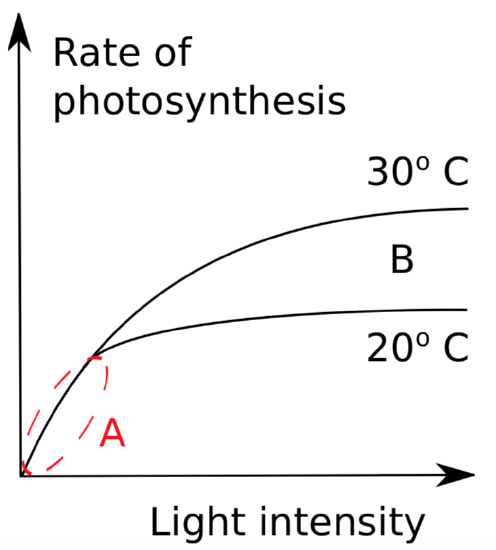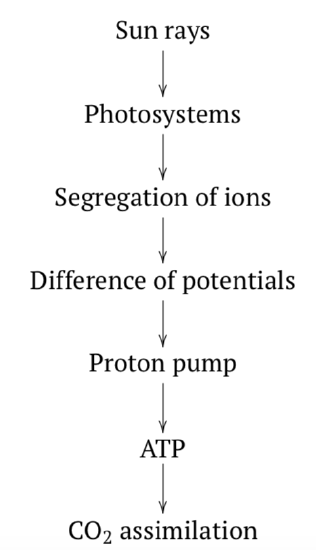3.2: Light Stage
- Page ID
- 17984
The light stage participants include photosystems (“chlorophyll”), light, water, ATPase, protons, and a hydrogen carrier (NADP\(^+\)).
The basic idea of light stage is that the cell needs ATP to assemble (later) carbon dioxide into sugar (Figure \(\PageIndex{2}\)). To make ATP, the cell needs electrical current: proton pump. To make this current, the cell needs the difference of electric charge (difference of potentials) between thylakoid (vesicle or membrane pocket) and matrix (stroma) compartments of the chloroplast (Figure 2.3.1). To make this difference, the cell needs to segregate ions: positively charged go from outside and stay inside, negatively charged go from inside to outside. To segregate, the cell needs the energy booster—sun rays caught by the chlorophyll molecules embedded in the thylakoid membrane. The chlorophyll molecule is non-polar (similarly to membrane lipids) and contains magnesium (Mg). It is easy to excite the chlorophyll molecule with light; excited chlorophyll may release the electron if the energy of light is high enough.
To make carbohydrates from carbon dioxide (CO\(_2\) apparently has no hydrogen), the cell needs hydrogen atoms (H) from hydrogen carrier, NADP+ which at the end of light stage, becomes NADPH.
The main event of the light stage is that chlorophyll reacts with light, yielding electron (\(e^-\)) and becoming oxygenated, positively charged molecule. Then electron, proton and NADP\(^+\) react to yield NADPH which will participate in enzymatic reactions later on. The positively

charged chlorophyll is extremely active chemically, therefore it splits water molecules (“photolysis of water”) into protons (which accumulate inside thylakoid), oxygen (O\(_2\)) and electron. The electron returns to chlorophyll. When increasing gradient reaches the threshold, the proton pump starts to work as protons (H\(^+\)) pass along the gradient. The energy of passing protons allows for the ATP synthesis from ADP and P\(_i\) (inorganic phosphate). On the other side of membrane, these protons make water with hydroxide ions.
In the previous paragraph, “chlorophyll” is actually two photosystems: photosystem II (P680) and photosystem I (P700). Photosystem II (contains chlorophyll and carotenes) is more important. It splits water, makes proton the gradient and then ATP, and forwards electrons to photosystem I. Photosystem I contains only chlorophylls and makes NADPH.
Ultimately, the light stage starts from light, water, NADP\(^+\), ADP and results in an accumulation of energy (ATP) and hydrogen (NADPH) with a release of oxygen which is a kind of exhaust gas (Figure 2.3.1).



